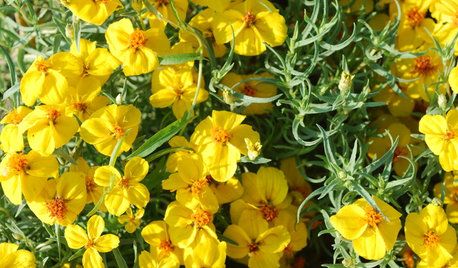Zinnia roots - width?
bugbite
11 years ago
Related Stories

GARDENING GUIDESGreat Design Plant: Rocky Mountain Zinnia Brightens Hot, Dry Spots
Sunshiny flowers provide a showy drift of color in desert and prairie gardens — this native perennial is hardier than it looks
Full Story
ARCHITECTURERoots of Style: Origins and Interpretations of the Bungalow
Bungalows translate effortlessly across continents and cultures to adapt comfortably to many styles and regions
Full Story
ARCHITECTURERoots of Style: The Eclectic American Foursquare
The turn-of-the-20th-century style transitioned U.S. residential architecture from the Victorian era to the modern age
Full Story
ARCHITECTURERoots of Style: Where Did Your House Get Its Look?
Explore the role of architectural fashions in current designs through 5 home styles that bridge past and present
Full Story
TRADITIONAL ARCHITECTURERoots of Style: Classical Details Flourish in 21st-Century Architecture
Columns, friezes, cornices ... if your home has features like these, it may have been influenced by ancient designs
Full Story
ARCHITECTURERoots of Style: Ranch Architecture Roams Across the U.S.
Great remodeling potential and generously spaced sites make ranch homes ever popular. Is one of the many variations right for you?
Full Story
ARCHITECTURERoots of Style: Many Cultures Make Their Marks on Mediterranean Design
If you live in California, Florida or certain other parts of the U.S., your architecture may show distinct cultural influences
Full Story
TRADITIONAL ARCHITECTURERoots of Style: Colonial Revivals Span Eras and Forms
Are the varied influences and configurations to thank for colonial revivals' ongoing popularity? Judge for yourself
Full Story
ARCHITECTURERoots of Style: See What Defines a Craftsman Home
Charming features and intimate proportions have made Craftsman houses an American favorite. See their common details and variations
Full Story
ARCHITECTURERoots of Style: Meet Your Traditional Home's Classical Ancestors
Traditional architecture's genes began in ancient Greece and Rome — discover your home's style forefathers here
Full Story







zen_man
bugbiteOriginal Author
Related Professionals
Beachwood Landscape Architects & Landscape Designers · Jennings Landscape Architects & Landscape Designers · Middletown Landscape Contractors · Cudahy Landscape Contractors · Lancaster Landscape Contractors · Methuen Landscape Contractors · Miller Place Landscape Contractors · North Highlands Landscape Contractors · Royal Oak Landscape Contractors · Thornton Landscape Contractors · Westmont Ironwork · Berkeley Driveway Installation & Maintenance · Fullerton Driveway Installation & Maintenance · Northbrook Driveway Installation & Maintenance · Northglenn Decks, Patios & Outdoor EnclosuresbugbiteOriginal Author
docmom_gw
bugbiteOriginal Author
Suzi AKA DesertDance So CA Zone 9b
zen_man